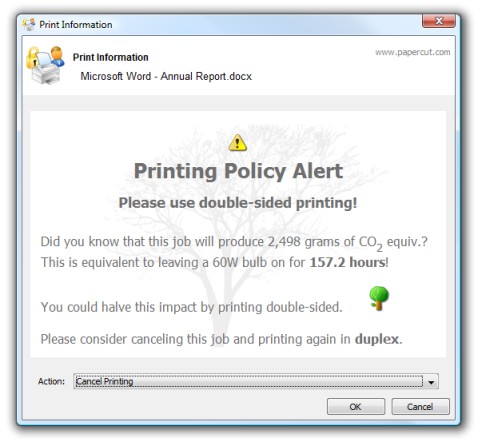
A rules-based printing strategy can get you on the route to a bulging bottom line.
Though we are interacting with information more and more online (PC, tablets, and phones), the need to print paper documents is still there. So, the question now becomes not whether or not you need to print, but how do you print in order to:
- Improve print efficiency – and productivity of employees
- Save money
- Meet any green initiatives
Printing rules, combined with an office-wide print strategy and policy, will help you achieve all three of those goals. Printing rules are designed to create effective user printing behavior and are based on conditions and consequences. You can establish different rules for different roles within your office with print rules, so that they can meet their legitimate printing needs.
What are the rules? Depending on the business, role, and individual, the rules can vary.
Here are a few common examples:
- Setting default printing to double-sided (duplex) printing. You can even create a pop-up alert that explains why duplex printing is the default. For instance, “This job will produce the equivalent of 2,498 grams of CO2 – that is the same as leaving a 60W bulb on for 157.2 hours! Printing double-sided halves this environmental impact.” You can also have rules to manage printing single-sided (when required).
- Creating strict or soft rules. Strict rules are firm. Soft rules can be overridden by the user (for example, printing duplex is the default, but being able to override when single-sided documents are needed).
- Printer failover. Avoid print queues from an “out of toner” status or if someone else is running an hours-long job on the device a job is initially sent to, by jobs being rerouted to printers that are actually available and ready to print. If a job is rerouted an alert can be sent to the users to notify them of the change in output device.
- Rules by the hour. Enforcement of rules can be limited to particular time periods – weekends, holidays, after office hours, etc.
- Keeping track of the rules. Rule events are logged, including when users decide to override a “soft” rule. Digging into these reports can reveal the users that consistently avoid the rules and point to opportunities for further efficiencies.
- Making your own. Many software tools will allow administrators to create job conditions, triggers, and the related actions and notifications so that new print rules can be created based on a business’ needs.
- Limiting printing from applications. Prints from the named application can be limited to black and white or prevent emails from being printed.
- Automatically route print jobs. Print jobs can be sent to a specific devices based on a set of conditions.
- If a job is over a certain page count, it will be routed to a high-speed device.
- Large and/or colored documents can be routed to more cost-effective printers, and send a message to the user once the print job has been completed.
- If you have a dedicated print room, route large jobs to it to avoid congestion for co-workers on lower-volume print devices while taking advantage of the cost-effectiveness and greater speed of the print room.
- Defaulting to black and white. Have all print jobs defaulted to black and white, even for jobs routed to color documents.
- Deleting duplicate print jobs. That way if someone has accidentally (or impatiently) clicked the “print” button more than once, you don’t end up with an excessive amount of the same five-page document.
- Discouraging the printing of emails via popup warnings
- Defaulting print jobs from websites to black & white and duplex
- Automatic messages. Making sure to provide the user with automatic messages regarding print job changes or cancelations
- Creating a “favorite job.” For documents that are often printed, instead of having to print from your PC, the file will remain in the queue at the printer.
- Deleting print jobs. Jobs can be deleted after a pre-set amount of time has passed. To ensure that stored jobs remain within the storage capacity of the central application, print quotas can be allocated to users and groups/departments.
 If you’re interested in ensuring adherence to the rules, contact your representative – the ability to use various print rules can require additional software beyond the standard set-up of copiers and printers.
If you’re interested in ensuring adherence to the rules, contact your representative – the ability to use various print rules can require additional software beyond the standard set-up of copiers and printers.

